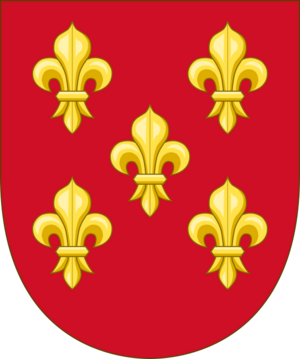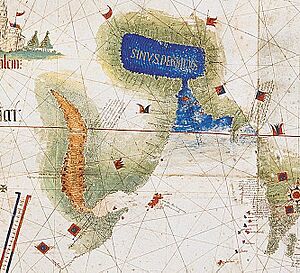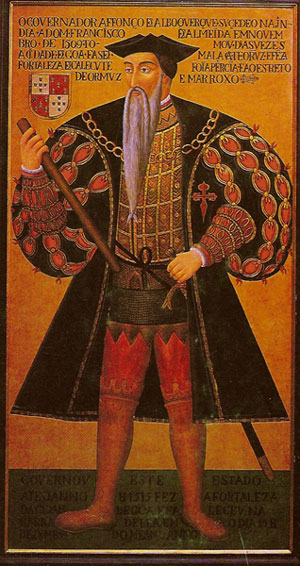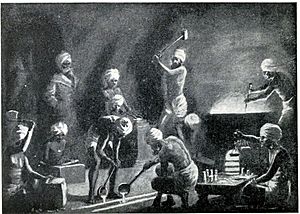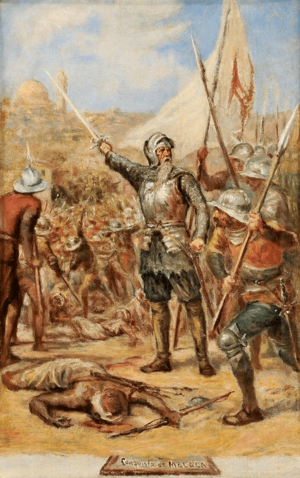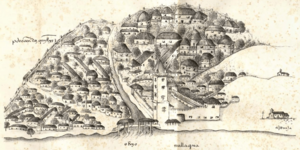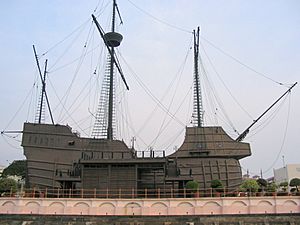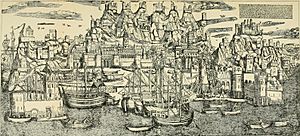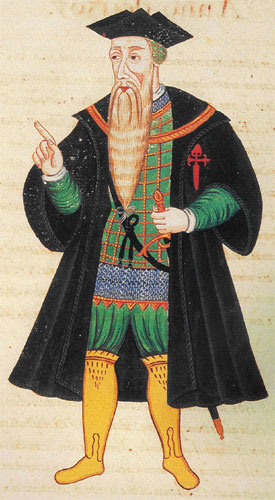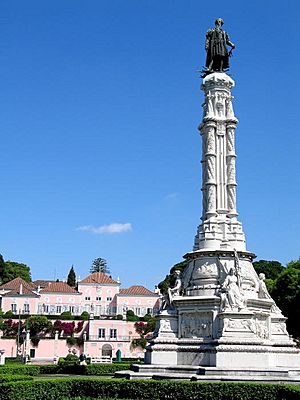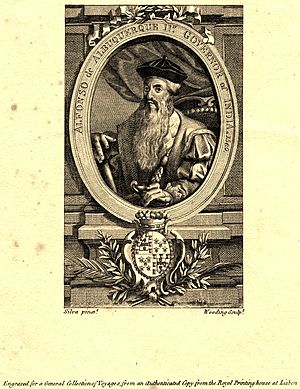Afonso de Albuquerque facts for kids
Quick facts for kids
Afonso de Albuquerque
|
|
|---|---|
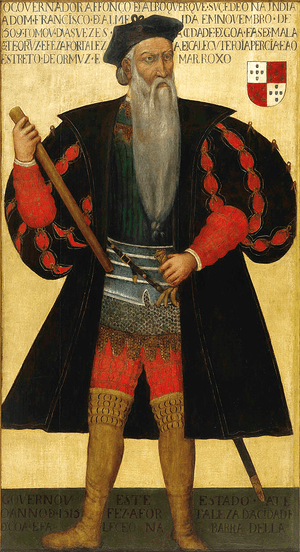 |
|
| Captain-Major of the Seas of Arabia Governor of Portuguese India |
|
| In office 4 November 1509 – September 1515 |
|
| Monarch | Manuel I |
| Preceded by | Francisco de Almeida |
| Succeeded by | Lopo Soares de Albergaria |
| Personal details | |
| Born |
Afonso de Albuquerque
c. 1453 Alhandra, Kingdom of Portugal |
| Died | 16 December 1515 (aged c. 62) Goa, Portuguese India |
| Children | Brás de Albuquerque |
| Parents |
|
| Occupation | Admiral Governor of India |
| Signature |  |
Afonso de Albuquerque, 1st Duke of Goa (born around 1453 – died 16 December 1515), was a famous Portuguese general, admiral, and leader. He was like a governor for Portuguese India from 1509 to 1515. During this time, he made Portugal much stronger in the Indian Ocean. He was known as a very good military leader.
Albuquerque helped Portugal achieve three main goals. These were fighting against some Muslim groups, spreading Christianity, and making sure Portugal controlled the valuable spice trade. He did this by building a Portuguese empire in Asia. Some of his biggest successes include taking over Goa. He was also the first European during the Renaissance to explore the Persian Gulf. He even led the first European ships into the Red Sea.
Many of his battles happened in the Indian Ocean. He fought for control of important trade routes in the Persian Gulf and along the coasts of India. His smart military plans helped Portugal become the first global empire in history. He led Portuguese forces in key battles. These included taking over Goa in 1510 and Malacca in 1511.
In his last five years, he focused on managing the new empire. His actions as the second governor of Portuguese India were very important. They helped the Portuguese Empire last a long time. He sent explorers to make friends with kingdoms like Ayutthaya Kingdom (Thailand) and Pegu (Myanmar). He also reached Timor and the Moluccas. He even helped open up trade with Ming China. He also made friends with Ethiopia and Persia.
People gave him many nicknames during his life. Some called him "the Terrible," "the Great," "the Lion of the Seas," "the Portuguese Mars," and "the Caesar of the East."
Contents
- Early Life and Education
- Early Military Career
- Governor of Portuguese India (1509–1515)
- Legacy and Impact
- Titles and Honors
- See also
- Images for kids
Early Life and Education
Afonso de Albuquerque was born in 1453 in Alhandra, near Lisbon, Portugal. His father, Gonçalo de Albuquerque, was an important person at the royal court. His mother was Dona Leonor de Menezes. Afonso was related to the Portuguese royal family through his father.
He learned about mathematics and Latin at the court of King Afonso V of Portugal. There, he became good friends with Prince John. This prince later became King John II of Portugal.
Early Military Career
In 1471, Afonso de Albuquerque joined the military under King Afonso V. He helped conquer Tangier and Arzila in Morocco. He served as an officer there for several years. In 1476, he fought alongside Prince John in wars against Castile. This included the Battle of Toro.
In 1480, he went to Italy to help Ferdinand I of Naples. They fought against the Ottoman Empire's invasion of Otranto. When he returned in 1481, Prince John became King John II. Albuquerque was given an important job as the king's chief horse master. He kept this job throughout John's rule. In 1489, he went back to North Africa to command a defense at the Graciosa fortress. His younger brother, Martim, died fighting beside him in 1495.
First Trip to India (1503)
When King Manuel I of Portugal became king, he was careful about Albuquerque. Albuquerque had been a close friend of the previous king. Eight years later, on 6 April 1503, Albuquerque went on his first trip to India. He sailed with his cousin, Francisco de Albuquerque. Each commanded three ships.
They fought several battles against the forces of the Zamorin of Calicut. They successfully helped the king of Cochin stay on his throne. In return, the king of Cochin allowed the Portuguese to build Fort Immanuel. This fort was in Kochi. They also started trading with Quilon (Kollam). This trip helped start the Portuguese Empire in the East.
Second Trip to India (1506)
Albuquerque returned to Portugal in July 1504. King Manuel I welcomed him. After helping plan Portugal's efforts in the East, the King gave him command of five ships. These ships were part of a larger fleet of sixteen. The fleet sailed for India in early 1506. It was led by Tristão da Cunha. The goal was to take over Socotra island and build a fort there. This would help control trade in the Red Sea.
Albuquerque was named "chief-captain for the Coast of Arabia." He sailed under da Cunha's command until they reached Mozambique. He carried a secret letter from the king. This letter said he was to replace the first viceroy of India, Francisco de Almeida, later on. Before leaving, he officially recognized his son, Brás, who was born in 1500.
Conquering Socotra and Ormuz (1507)
The fleet left Lisbon on 6 April 1506. Albuquerque steered his own ship because his pilot left. In the Mozambique Channel, they rescued Captain João da Nova. His ship, the Frol de la mar, joined the fleet. From Malindi, da Cunha sent messengers to Ethiopia. Albuquerque helped land these messengers.
After successful attacks on Arab cities in East Africa, the group took over Socotra island. They built a fort there. They hoped this would stop trade from the Red Sea to the Indian Ocean. However, Socotra was later left because it was not a good location for a base.
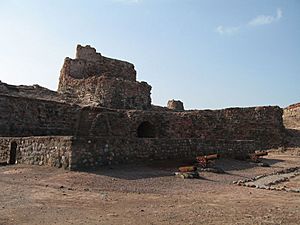
At Socotra, the fleet split up. Tristão da Cunha sailed to India. Afonso took seven ships and 500 men to Ormuz in the Persian Gulf. Ormuz was a major trading center. On his way, he conquered cities like Curiati, Muscat, and Khor Fakkan. He also received the surrender of Kalhat and Sohar. He arrived at Hormuz on 25 September and quickly captured the city. Hormuz agreed to pay tribute to the Portuguese king.
Ormuz was paying tribute to Shah Ismail of Persia at the time. A famous story tells that Persian messengers demanded tribute from Albuquerque. He told them he would pay with cannonballs, arrows, and weapons. He said, "such was the currency struck in Portugal to pay the tribute demanded from the dominions of King Manuel." Shah Ismael reportedly called Albuquerque "Lion of the seas."
Afonso started building a fort on Hormuz Island. He made all his men, even officers, help with the hard work. But some officers complained that he was going beyond his orders. They left for India. With only two ships and no supplies, he could not hold his position. In January 1508, he had to leave Ormuz. He raided villages for supplies for Socotra. Then he returned to Ormuz and headed to India.
Arrest in Cannanore (1509)
Afonso arrived at Cannanore in December 1508. He opened the secret letter from the king. It said he was to become the new governor, replacing Francisco de Almeida. But Almeida, supported by officers who had left Afonso at Ormuz, refused to step down. He said his term ended later and wanted to fight the Mamluk fleet. Afonso avoided a fight to prevent a civil war. He went to Kochi, India, to wait for the king's orders.
On 3 February 1509, Almeida fought and won the Battle of Diu against a combined fleet. This victory made it easier for Portugal to control the Indian Ocean. In August, Afonso's former officers and Diogo Lopes de Sequeira claimed he was not fit to govern. Afonso was then held captive at St. Angelo Fort in Cannanore. He felt this was an imprisonment.
Governor of Portuguese India (1509–1515)
Afonso was set free after three months. This happened when Marshal of Portugal Fernando Coutinho arrived in Cannanore. He brought a large fleet from the king. Coutinho was a very important Portuguese noble. He came with fifteen ships and 3,000 men to support Afonso.
On 4 November 1509, Afonso became the second Governor of Portuguese India. He held this job until he died. Almeida left to return to Portugal but was killed in a fight before he got there. As governor, Afonso wanted to control the Muslim world and the Spice trade.
King Manuel I first tried to share power in the Indian Ocean. In 1509, Diogo Lopes de Sequeira was sent to Southeast Asia. He tried to make a deal with the Sultan of Malacca, but failed.
Taking Over Goa (1510)
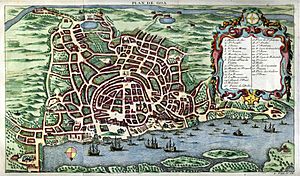
In January 1510, Afonso attacked Calicut as the king ordered. The attack started well. But Marshal Coutinho, wanting glory, attacked the Zamorin's palace against Afonso's advice. He was ambushed and killed. Afonso was badly hurt and barely escaped.
After this failed attack, Afonso gathered 23 ships and 1200 men. He heard from Timoji, a local leader, that it would be easier to fight the Egyptian Mamluk fleet in Goa. They had hidden there after the Battle of Diu. He also learned that the Sultan of Bijapur was sick. So, he decided to surprise Goa.
The first attack on Goa was from 4 March to 20 May 1510. After taking the city, Afonso felt he could not hold it. The forts were in bad shape, Hindu support was fading, and his men were disobeying. He refused a peace offer and left the city in August. His fleet scattered. New ships arrived from Portugal.
Three months later, on 25 November, Afonso returned to Goa with a stronger fleet. They took Goa from Ismail Adil Shah and his allies in less than a day. This happened on 10 December. It's thought that 6000 of the 9000 Muslim defenders died. Afonso got the support of the Hindu people again. He made Timoji the chief administrator of the city. He also agreed to lower the yearly tribute.
In Goa, Afonso started the first Portuguese mint in the East. This happened because merchants complained about not enough money. The new coins had a cross on one side and King Manuel's symbol, an armillary sphere, on the other.
Albuquerque also started the Royal Hospital of Goa. He heard that doctors were charging sick people too much. He made them work on building city walls all day. This taught them a lesson.
Goa became the most important Portuguese settlement in India. Neighboring kingdoms like the Sultan of Gujarat and the Zamorin of Calicut sent messengers. They offered alliances. Afonso used Goa to control the spice trade for Portugal. He also sold Persian horses to Indian princes for their help.
Taking Over Malacca (1511)
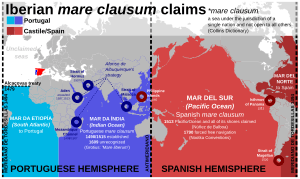
Afonso explained to his soldiers why taking Malacca was important: "The King of Portugal wants me to go to the Straits. This is the best place to stop the trade that Muslims do here. By taking Malacca, we would close the Straits. Muslims would never again bring spices this way. I am sure that if we take this trade from them, Cairo and Mecca will lose everything."
In February 1511, Afonso received a letter from Rui de Araújo. He was one of nineteen Portuguese held captive in Malacca. The letter asked for a large fleet to free them. It also gave details about the city's defenses. Afonso gathered about 900 Portuguese soldiers, 200 Hindu fighters, and eighteen ships. He sailed to Malacca, even though some disagreed. He wanted to control the Portuguese government in the Indian Ocean. Ferdinand Magellan was with him.
Malacca was the richest city the Portuguese tried to take. It was a key trading center for many different merchants. It was mostly built of wood, but had many defenders. Its biggest weakness was that the government of Sultan Mahmud Shah was not popular. He favored Muslims, which made other merchants unhappy.
Afonso approached the city boldly. His ships had banners and fired cannons. He said he was the lord of all shipping. He demanded the Sultan free the prisoners and pay for damages. He also wanted to build a fortified trading post. The Sultan freed the prisoners but was not impressed by the small Portuguese force. Afonso then burned some ships and buildings to show his power.
The city was divided by the Malacca River. The bridge was a key point. On 25 July, the Portuguese landed and fought hard. They faced poisoned arrows but took the bridge by evening. The next day, all soldiers landed. After a fierce fight, the Sultan fled. Afonso waited for the Sultan's reaction. Merchants asked for Portuguese protection. They were given banners to mark their places so they would not be looted. On 15 August, the Portuguese attacked again. The Sultan had already fled the city. The Portuguese looted the city but respected the banners.
Afonso prepared Malacca's defenses against a counterattack. He built a fortress using stones from a mosque and cemetery. It was finished in November 1511. Its surviving gate is now called "A Famosa" ('the famous'). He also had a large stone carved with the names of those who helped in the conquest.
He set up the Portuguese government in Malacca. He reappointed Rui de Araújo as the trade agent. He also appointed Nina Chatu, a rich merchant, to help govern the city. Afonso had a powerful Javanese merchant, Utimuti Raja, arrested and executed. This merchant had kept in touch with the exiled royal family.
Shipwreck of the Flor de la Mar (1511)
On 20 November 1511, Afonso sailed from Malacca to the Malabar coast. He was on the old Flor de la Mar ship. Even though it was not in good condition, he used it to carry the treasures from the conquest. He wanted to show King Manuel's court the riches of Malacca. There were also gifts from the Ayutthaya Kingdom (Thailand) for the king. On the journey, the Flor de la Mar was destroyed in a storm. Afonso barely survived.
Missions from Malacca
Messengers to Pegu, Sumatra, and Siam (1511)
Most Muslim and Gujarati merchants had left Malacca. Afonso focused on making friends with Southeast Asian merchants, like the Chinese. He wanted good relations with Portugal. Trade and diplomatic missions were sent to other kingdoms. Rui Nunes da Cunha went to Pegu (Burma). King Binyaram sent a friendly messenger back to Kochi in 1514. Kings from Sumatra also sent messengers to Afonso, accepting the new Portuguese power.
Knowing that Siam wanted Malacca, Afonso sent Duarte Fernandes on a mission to the Ayutthaya Kingdom (Thailand). Fernandes returned in a Chinese ship. He was one of the Portuguese who had been arrested in Malacca. He had learned a lot about the region's culture. He was the first European to arrive there. He made friendly relations between Portugal and the court of King Ramathibodi II of Siam. He returned with a Siamese messenger carrying gifts and letters for Afonso and the King of Portugal.
Trip to the "Spice Islands" (Moluccas) (1512)

In November, after securing Malacca, Afonso learned where the secret "spice islands" were. He sent three ships to find them. They were led by António de Abreu and Francisco Serrão. Malay sailors guided them through Java, the Lesser Sunda Islands, and Ambon Island to the Banda Islands. They arrived in early 1512. They stayed for a month, buying nutmeg and cloves. António de Abreu then sailed to Amboina. Serrão sailed towards the Moluccas but was shipwrecked. The Sultan of Ternate heard about them. He saw a chance to make friends with a powerful foreign nation. He brought them to Ternate in 1512. They were allowed to build a fort on the island, which was built in 1522.
Return to Cochin and Goa
Afonso returned from Malacca to Cochin. But he could not sail to Goa. Goa was facing a serious revolt led by the forces of Ismael Adil Shah, the Sultan of Bijapur. During Afonso's time away, some Portuguese who did not want to keep Goa had given up on it. They even wrote to the king saying it would be best to let Goa go. Afonso had to wait for more ships and soldiers to arrive.
While in Cochin, Albuquerque started a school. He wrote to King Manuel I that he found many books. He used them to teach the children of Portuguese settlers and Christian converts to read and write. There were about a hundred children.
On 10 September 1512, Afonso sailed from Cochin to Goa. He had fourteen ships and 1,700 soldiers. He was determined to take back the fort. He ordered trenches dug and a wall broken. But on the day of the final attack, Rasul Khan, the enemy leader, surrendered. Afonso demanded the fort, its weapons, and the soldiers who had left the Portuguese side. Rasul Khan agreed, as long as their lives were spared. Afonso agreed and left Goa. He did spare the lives of the deserters. One of them, Fernão Lopes, escaped and lived like "Robinson Crusoe" for many years. After these events, Goa became the richest Portuguese settlement in India.
Campaign in the Red Sea (1513)
In December 1512, a messenger from Ethiopia arrived in Goa. Mateus was sent by Queen Eleni. She wanted to find an ally to help fight against growing Muslim influence. Afonso welcomed him with great honor. He saw him as a messenger from the legendary "Prester John". King Manuel announced his arrival to Pope Leo X in 1513. Even though some of Afonso's rivals did not trust Mateus, Afonso sent him to Portugal. The king was very happy to hear their report.
In February 1513, while Mateus was in Portugal, Afonso sailed to the Red Sea. He had about 1000 Portuguese and 400 Indian soldiers. He was ordered to secure that area for Portugal. Socotra had not been good for controlling the Red Sea entrance. Afonso thought Massawa could be a good base.
He knew the Mamluks were preparing another fleet. He wanted to attack before more soldiers arrived in Aden. So, he attacked the city. Aden was a strong city. His ladders broke during the attack. After half a day of hard fighting, Afonso had to retreat. He sailed into the Red Sea, becoming the first European fleet to do so. He tried to reach Jeddah, but the winds were bad. He stayed at Kamaran island in May. But sickness and lack of fresh water forced him to leave. In August 1513, after a second try to reach Aden, he returned to India without much success. He even suggested diverting the Nile river to make Egypt barren. He also wanted to steal the body of the Islamic prophet, Muhammad, to hold it for ransom.
Even though Albuquerque's trip did not reach Suez, this first Christian fleet in the Red Sea surprised the Muslim world. Panic spread in Cairo.
Calicut Makes Peace
Albuquerque successfully ended the fighting between the Portuguese and the Zamorin of Calicut. This conflict had been going on since 1502. Trade was suffering, and local leaders were leaving the Zamorin. The Zamorin's court started fighting among themselves. The ruling Zamorin was killed and replaced by a rival. Albuquerque helped make this happen. This allowed peace talks to begin.
The Portuguese were allowed to build a fort in Calicut. They also got the right to buy as much pepper and ginger as they wanted at set prices. They also received half of Calicut's customs duties as yearly tribute. Building the fort started right away.
Managing and Diplomacy in Goa (1514)
With peace made, Afonso focused on governing Goa in 1514. He welcomed messengers from Indian governors. He made the city stronger. He also encouraged Portuguese men to marry local women. At that time, Portuguese women were not allowed to travel overseas. In 1511, Afonso started a policy to encourage explorers to marry local women. To help people settle, the King of Portugal gave special status to Portuguese men who married local women. These men were called casados (married men). They did not have to pay certain taxes. With Afonso's help, mixed marriages grew. This led to the birth of Portuguese-Indians, or mestiços. He gave local people jobs in the Portuguese government. He also did not interfere with local traditions.
In March 1514, King Manuel sent a large and unusual group of messengers to Pope Leo X. This group was led by Tristão da Cunha. They paraded through Rome with exotic animals and riches from India. Afonso's reputation grew even more. This helped build the Portuguese Empire in the East.
In early 1514, Afonso sent messengers to Gujarat's Sultan Muzaffar Shah II. He ruled Cambay. Afonso wanted permission to build a fort on Diu, India. The mission did not get an agreement. But they exchanged gifts. One gift was an Indian rhinoceros. Afonso sent this rhino to King Manuel. It was the first living rhinoceros seen in Europe since the Roman Empire.
Conquering Ormuz and Illness
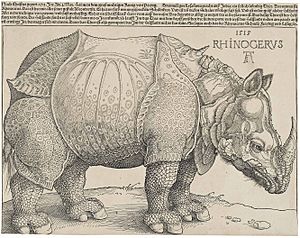
In 1513, in Cannanore, Afonso met a Persian messenger from Shah Ismail I. The shah's messenger invited Afonso to send a representative back to Persia. Miguel Ferreira was sent to Tabriz through Ormuz. He met with the shah several times to discuss working together against the Mamluk sultan.
At the same time, Albuquerque decided to fully conquer Hormuz. He learned that after the Portuguese left in 1507, a young king was ruling. This king was controlled by a powerful Persian vizier, Reis Hamed. The king was very afraid of him. In Ormuz in March 1515, Afonso met the king. He asked the vizier to be there. Then, Afonso had the vizier killed by his men. This "freed" the terrified king. So, the island in the Persian Gulf gave in to him without a fight. It remained a Portuguese territory. Ormuz would not be Persian for another century.
In Ormuz, Afonso met Miguel Ferreira, who returned with gifts and a messenger. The messenger carried a letter from Shah Ismael. The shah invited Afonso to become an important lord in Persia. Afonso stayed there, working on diplomacy. He received messengers and watched the building of the new fort. He became more and more ill. His illness was reported in September 1515. In November 1515, he started his journey back to Goa.
Death
At this time, his enemies in the Portuguese court were planning his downfall. They made King Manuel jealous of him. They hinted that Afonso wanted to take power in Portuguese India. On his way back from Ormuz, near the harbor of Chaul, he heard news. A Portuguese fleet had arrived from Europe. It brought news that he would be replaced by his enemy, Lopo Soares de Albergaria. He realized his enemies had plotted against him. He felt very sad and said, "My sins must be great before the King. I am out of favor with the King for loving the men, and with the men for loving the King."
Feeling that he was dying, he put on his knight's coat. He wrote his will. He appointed new captains for Ormuz. He held a final meeting with his captains to decide important matters for Portuguese India. He wrote a short letter to King Manuel. He asked the king to give his son "all of the high honors and rewards" that Afonso had received. He also assured Manuel of his loyalty.
On 16 December 1515, Afonso de Albuquerque died as his ship approached Goa. When his death was known, there was "great wailing" in the city. Many people went into the streets to see his body. His main captains carried him on a chair in a procession with torches. Afonso's body was buried in Goa, as he wished. He was buried in the Church of Nossa Senhora da Serra (Our Lady of the Hill). He had built this church in 1513 to thank the Madonna for his escape from Kamaran island. That night, the people of Goa, both Hindu and Portuguese, gathered to mourn him.
In Portugal, King Manuel's decisions kept changing. He did not know that Afonso had died. He heard rumors that the Mamluk Sultan of Egypt was preparing a large army. This army was meant to stop the conquest of Ormuz. The king regretted replacing Afonso. In March 1516, he urgently wrote to Albergaria. He ordered him to give command of all operations back to Afonso. He also told him to give Afonso resources to fight the Egyptian threat. He organized a new Portuguese navy in Asia. He ordered that Afonso (if he was still in India) be made commander-in-chief against the Sultan of Cairo's armies. Manuel later learned that Afonso had died many months earlier. His changed decision was delivered too late.
After 51 years, in 1566, his body was moved to Nossa Senhora da Graça church in Lisbon. This church was later ruined and rebuilt after the 1755 Great Lisbon earthquake.
Legacy and Impact
King Manuel I of Portugal finally believed in Afonso's loyalty. He tried to make up for his lack of trust. He gave many honors to Afonso's son, Brás de Albuquerque (1500–1580). He even renamed him "Afonso" to remember his father. Afonso de Albuquerque wrote many letters during his time as governor. These letters covered everything from small issues to big plans. In 1557, his son published his life story called Commentarios do Grande Affonso d'Alboquerque.
In 1572, Afonso's actions were written about in The Lusiads. This is a famous Portuguese epic poem by Luís Vaz de Camões. The poem praises his achievements.
A special kind of mango was created by Portuguese Jesuits in Goa. It was named in his honor.
Many tributes have been made to Afonso. He is shown in the Padrão dos Descobrimentos monument. There is a square named after him in Lisbon. It has a bronze statue of him. Two Portuguese Navy ships have also been named after him.
Titles and Honors
- Captain-Major of the Sea of Arabia
- 2nd Governor of India
- 1st Duke of Goa
- A knight of the Portuguese Order of Saint James of the Sword
- Fidalgo of the Royal Household
See also
 In Spanish: Afonso de Albuquerque para niños
In Spanish: Afonso de Albuquerque para niños
Images for kids


